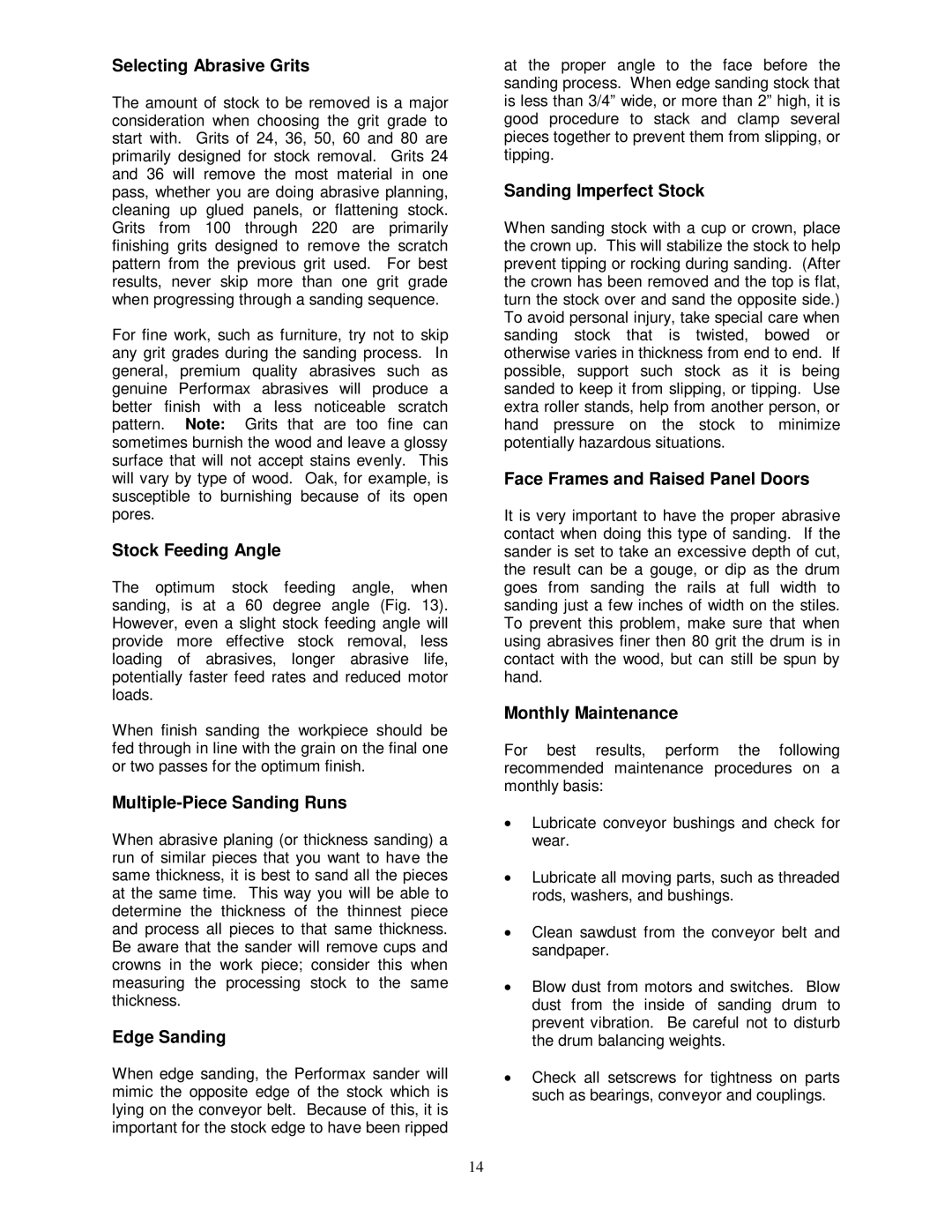Selecting Abrasive Grits
The amount of stock to be removed is a major consideration when choosing the grit grade to start with. Grits of 24, 36, 50, 60 and 80 are primarily designed for stock removal. Grits 24 and 36 will remove the most material in one pass, whether you are doing abrasive planning, cleaning up glued panels, or flattening stock. Grits from 100 through 220 are primarily finishing grits designed to remove the scratch pattern from the previous grit used. For best results, never skip more than one grit grade when progressing through a sanding sequence.
For fine work, such as furniture, try not to skip any grit grades during the sanding process. In general, premium quality abrasives such as genuine Performax abrasives will produce a better finish with a less noticeable scratch pattern. Note: Grits that are too fine can sometimes burnish the wood and leave a glossy surface that will not accept stains evenly. This will vary by type of wood. Oak, for example, is susceptible to burnishing because of its open pores.
Stock Feeding Angle
The optimum stock feeding angle, when sanding, is at a 60 degree angle (Fig. 13). However, even a slight stock feeding angle will provide more effective stock removal, less loading of abrasives, longer abrasive life, potentially faster feed rates and reduced motor loads.
When finish sanding the workpiece should be fed through in line with the grain on the final one or two passes for the optimum finish.
Multiple-Piece Sanding Runs
When abrasive planing (or thickness sanding) a run of similar pieces that you want to have the same thickness, it is best to sand all the pieces at the same time. This way you will be able to determine the thickness of the thinnest piece and process all pieces to that same thickness. Be aware that the sander will remove cups and crowns in the work piece; consider this when measuring the processing stock to the same thickness.
Edge Sanding
When edge sanding, the Performax sander will mimic the opposite edge of the stock which is lying on the conveyor belt. Because of this, it is important for the stock edge to have been ripped
at the proper angle to the face before the sanding process. When edge sanding stock that is less than 3/4” wide, or more than 2” high, it is good procedure to stack and clamp several pieces together to prevent them from slipping, or tipping.
Sanding Imperfect Stock
When sanding stock with a cup or crown, place the crown up. This will stabilize the stock to help prevent tipping or rocking during sanding. (After the crown has been removed and the top is flat, turn the stock over and sand the opposite side.) To avoid personal injury, take special care when sanding stock that is twisted, bowed or otherwise varies in thickness from end to end. If possible, support such stock as it is being sanded to keep it from slipping, or tipping. Use extra roller stands, help from another person, or hand pressure on the stock to minimize potentially hazardous situations.
Face Frames and Raised Panel Doors
It is very important to have the proper abrasive contact when doing this type of sanding. If the sander is set to take an excessive depth of cut, the result can be a gouge, or dip as the drum goes from sanding the rails at full width to sanding just a few inches of width on the stiles. To prevent this problem, make sure that when using abrasives finer then 80 grit the drum is in contact with the wood, but can still be spun by hand.
Monthly Maintenance
For best results, perform the following recommended maintenance procedures on a monthly basis:
•Lubricate conveyor bushings and check for wear.
•Lubricate all moving parts, such as threaded rods, washers, and bushings.
•Clean sawdust from the conveyor belt and sandpaper.
•Blow dust from motors and switches. Blow dust from the inside of sanding drum to prevent vibration. Be careful not to disturb the drum balancing weights.
•Check all setscrews for tightness on parts such as bearings, conveyor and couplings.
14
